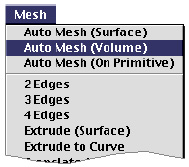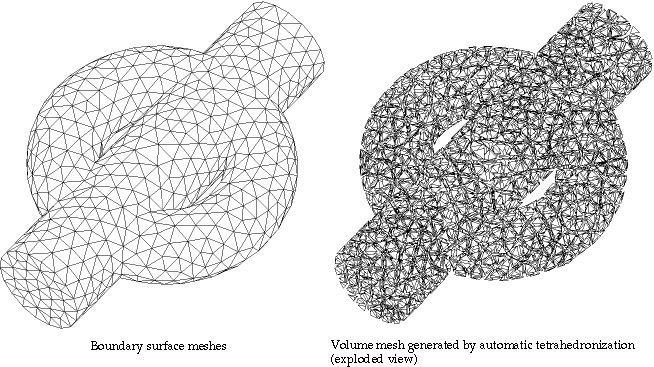![]()
| Mesh Generation > Volume Mesh Generation > Volume mesh generation by automatic tetrahedronization |
|
|
|
|
||
Volume mesh generation by automatic tetrahedronization
Automatic tetrahedronization is one of the most advanced technique generating 3- dimensional volume meshes. This method is analogous to automatic triangulation for surface mesh generation. Automatic tetrahedronization fills a volume s u r rounded by boundary surface meshes, while automatic triangulation fills an area surrounded by boundary curves. The boundary surface meshes should form a closed surface enclosing a 3-dimensional space. A volume mesh is generated by an algorithm subdividing the volume space recursively along the surface element boundaries. A volume element is created at each end of the recursion. This method is very powerful and useful, because a volume mesh can be generated, with minimum user interaction, in a relatively arbitrarily shaped space. There is no requirement for convexity of the space. Only 4 node and 10 node tetrahedron elements can be generated by tetrahedronization in the current version of VisualFEA.
> Generating mesh by automatic tetrahedronization
 |
A volume mesh can be generated by automatic tetrahedronization technique in a 3-dimensional space surrounded by closed surface meshes. The element shape generated by automatic tetrahedronization is limited to tetrahedron in the current version of VisualFEA. Either 4 or 10 node elements can be generated. If elements within the boundary meshes are 3-node triangles, 4-node tetrahedral elements will be generated. If elements within the boundary meshes are 6-node triangles, 10-node tetrahedral elements will be generated. |
In the above procedure, the order of step 2), 3) and 4) can be interchanged. You may repeat the above procedure of generating a mesh by automatic tetrahedronization without issuing the command again, while "Auto Mesh Volume" dialog remains on the screen. This mesh generation command is terminated by closing the dialog box or issuing any other command. Automatic tetrahedronization usually takes a long time. While mesh generation is progressing, its status is indicated by a progress bar.

The pro g ress bar is not to the actual time scale. The display indicates only the progress in the recursion stages. If "Visualize process" box is checked, the recursive process of mesh generation is also graphically visualized.
> Forming boundary meshes for automatic tetrahedronization
For successful automatic tetrahedronization, surface meshes should be selected so that they form a boundary surfaces acceptable for mesh generation as described below.
| The selected meshes should form a closed boundary surface enclosing the 3- dimensional region in which new volume mesh is to be generated. | |
| The region may be either convex or concave, but cannot contain another volume (pocket). | |
| All the elements of the boundary meshes should be triangular. | |
| All the elements of the boundary meshes should have equal number of nodes. That is, the number of nodes in every element should be uniformly either 3 or 4. |
The automatic tetrahedronization will be aborted if the above conditions are not satisfied. The mesh generation may also fail if the 3-dimensional space is too complex. In this case, the space should be broken into two or more sub-regions which are simpler, and the automatic tetrahedronization should be applied for each of these sub-regions.

< Example of volume mesh generation by automatic tetrahedronization >
|
|
|
|